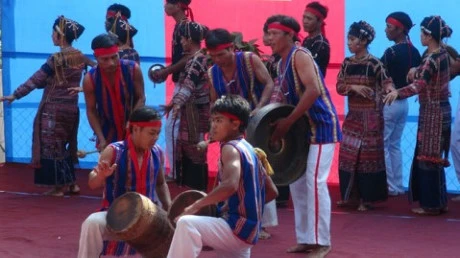Hanoi (VNA) - The Muong ethnic group is a minority group with many of its people residing in the western outskirt districts of My Duc, Ba Vi and Thach That in Hanoi.
In the development process, the Muong have tried to preserve their traditional art of playing gongs.
To the Muong, gongs are not only tools for humans to communicate with Gods, they are also valuable property to families and villages, gong artisan Bui Thi Bich Thin said.
“Each gong set consists of 12 pieces, which resemble the 12 months, and also the harmony between the universe, heaven, earth and human beings,” she said.
“The Muong people believe that gongs have souls. When they let them rest, they put the gongs with nubs downwards, otherwise, the gongs will lose their sounds. Whenever they start a performance, they hold a ceremony to test the sounds as a way to ask the permission from the gong’s soul,” she added.
Gongs are used as musical instruments in important events throughout the life of the Muong people including welcoming a new-born, weddings, new house celebrations, village festivals and funerals.
Thin said that two ancient gong melodies still popular nowadays are Xac Bua and Bong Trang Bong Vang, which used to be played at the important events in the village.
Xac Bua is often played in spring time as a musical background for folk songs.
Artisan Thin, herself, is the only person who possesses a set of 12 pieces of gongs in Hanoi.
Though she was born into a farmer’s family, in the northern province of Hoa Binh, she soon expressed her art for passion and talent.
At 8, she worked as a babysitter for a rich family in her village, where she had a chance to learn how to play gongs. After school, she worked as an office staff at the local People’s Committee. She then took a theatre director’s course at today’s Hanoi Culture University.
Before 2008, Tien Xuan commune in Luong Son district of the northern province of Hoa Bình, where she lived, was considered the birthplace of gong art of the Muong group. Then the region merged with Hanoi city, and after that she brought her gongs to teach the Muong people in other localities in the city.
At present, she is a teacher of 27 gong groups in Hanoi and the central province of Thanh Hoa with some 300 learners.
“We are from the Muong group. We love gongs, but no one in our village knew how to play,” Nguyen Thi Vinh, from Van Ha commune, Ba Vi district, said.
“Early this year, I watched a TV programme on Thin and was very happy that there was such a person with such a passion for gongs. We asked her to spare two nights a week so that we could come to her house to learn. Though we have just started, we have learnt a lot about the history and culture of our group,” Vinh said.
Some groups Thin trained have performed in many places. In early 2014, a gong group from her hometown, together with Hanoi Dancers’ Association, performed at Ly Thai To Park in downtown Hanoi.
“Many elders of the Muong group from other localities even burst into tears as the show stirred their memories of the past with its ancient melodies,” Thin said.
Together with training people, artisan Thin has also gathered photos of the art to share the traditional value of her homeland.
Van Hoa commune in Ba Vi district, about 50km to the west of Hanoi’s centre, hosts various ecological tourism sites such as Khoang Xanh, Suoi Tien, and Thien Son – Suoi Nga. The commune also hosts three groups of Kinh, Muong and Dao.
Since 2015, the commune has set up gong clubs in every hamlet to perform at home and in other localities.
Gong club in Ban hamlet is the youngest club with 20 members who are women farmers aged between 35 and 68.
There are more than one million people of the Muong group throughout Vietnam’s north and central regions. They reside in valleys along the Da River in the north and the Ma and Buoi Rivers in the central province of Thanh Hoa.
The Muong people possess a rich folk literature and arts of folk lullabies, legends, epics and gongs.-VNA

























